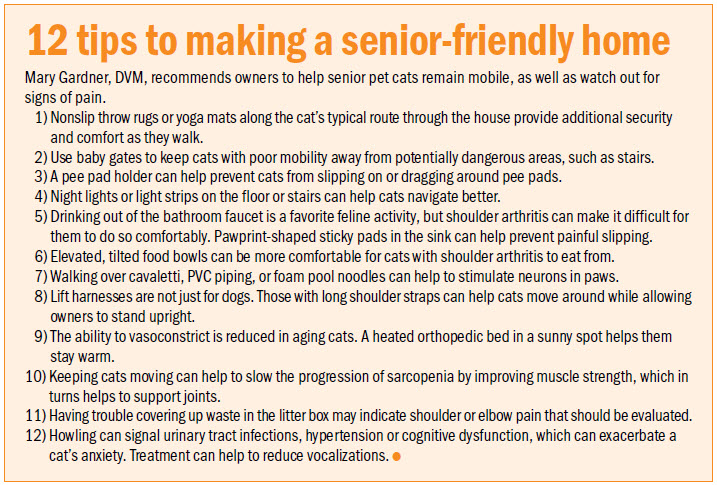
The biggest problem in treating geriatric cats is getting them into the clinic to be seen. Clients bring kittens to the veterinarian for vaccinations and spay/neuter surgery, but as cats mature and are seemingly doing well, people may see less need to bring them in, especially if cats are shy or dislike car rides or leaving the home.
By the time cats are mature, at seven to 10 years,1 or seniors—defined as older than 10 years2 —they may not have been to the veterinarian in years unless owners have noticed an obvious problem, such as parasite-related pruritus or a bite wound from another animal.
Partly this is because cats are past masters at hiding illness. They are not as active as dogs, so the fact they are spending a lot of time sleeping does not seem unusual to clients. Cats fluff up their fur, making weight loss less noticeable. They are not as “vocal” as dogs when they feel unwell. Clients may also wish to avoid stressing their cat with what seems like an unnecessary veterinary exam.
“I think clients, over time, feel like their cats need vaccinations less and less, and they’re not wrong, but that was the reason they were going to the vet,” says Drew Weigner, DVM, ABVP. “Once you get the mindset that they don’t need their vaccinations anymore, the length of time between visits lengthens astronomically.”
That is detrimental to cat patients and to veterinary practices, given the many advances in feline healthcare. Much can be done for senior cat comfort and well-being—if they are brought to the clinic on a regular basis before problems begin or at the early stages.
Raising awareness
Sometimes, it is necessary to bring clients to an awareness their cats are seniors, Dr. Weigner says. It often comes as a surprise to owners that their pet has hit the golden years.
Weigner tries to keep the conversation light: “I tell them, ‘Your cat is 11. If he were a person, he’d qualify for Medicare.’ It’s an education process and the time to talk about it is when their cats aren’t showing signs of disease. That doesn’t mean they don’t have anything wrong with them, but if you find something at that point, it’s usually very straightforward to treat them.”
Getting cats into the clinic
Mary Gardner, DVM, co-founder of Lap of Love Hospice, who lectures frequently on senior and end-of-life pet care, sees cats living longer because of the availability of better nutrition and medicine. However, Dr. Gardner recognizes it is not easy to persuade clients to bring their pets in for wellness exams annually, let alone the recommended twice yearly to ensure early detection and treatment of chronic conditions and mobility issues.
Different approaches to marketing and communication may help. Clients may need to see the type of pet they have represented on websites or in brochures to recognize their cat could have issues that need treatment or that something can be done for what they may have considered “normal” aches and pains of age.
“We’re so focused on puppies and kittens and adult pets in all of our marketing,” Gardner says. “I don’t think we focus on the weak and the wobbly and the skinny and the stinky enough. Forty-four percent of the pet population is senior and geriatric,3 and the pictures on our websites are all young, healthy-looking cats. Get an old-looking crinkle cat on there. That’s what I want to see.”
Use your online platforms to point cat owners toward products that can help them care for aging pets. Dr. Gardner has an Amazon page4 for this purpose. She walks through Target and videos inexpensive and widely available household items that can help seniors be more comfortable in the home, such as baby wipe warmers or large, shallow plastic containers that can double as litter boxes. Gardner also has a YouTube channel with videos on senior care.
A common concern Gardner hears from pet owners is having their pets anesthetized, especially for dental procedures.
“Do a video on that,” she says. “Leave it on your website about all the things your clinic does to ensure cats are safe under anesthesia.”
A simpler method can be text or email blasts to clients to bring attention to the needs of senior cats and news about the latest treatment options, home monitoring equipment, and environmental enrichment. Communicating early and often can be a way to ease clients into the idea that as their cats age, they should have more frequent veterinary visits and lab work. That way, clients are prepared for it when they come in and it will not be a shock when a procedure is suggested, says Lauren Brower, DVM, who practices at Arch Beach Veterinary Clinic in Laguna Beach, Calif.
“There are more and more tools available for cat owners so they can monitor at home and that can raise a red flag for issues they might not notice otherwise,” she says. One Dr. Brower learned about recently is a litter box that tracks a cat’s weight and measures frequency of urination and volume of urine. An app allows the information to be sent to the veterinarian, who can alert owners to unusual weight loss or gain and recommend
an exam.
Using Cat Friendly Practice techniques can help, too, Weigner says. The global program was developed by the American Association of Feline Practitioners5 and the International Society for Feline Medicine6 in countries outside North and South America. Fear Free Pets also offers training on helping cats to be more comfortable on the way to and in the clinic.
Dig deep with questions
To help clients bring out or become aware of what is going on with their cats, Brower asks about the size of the clumps in the litter box, whether cats are able to leap onto the sofa or windowsill, or if they have a new favorite spot lower to the ground, and how they move when they jump down from furniture. For instance, creeping down the side rather than jumping straight off.
“Owners think back and say, ‘You’re right, I’m having to clean the litter box every day instead of every other day’ or ‘The clumps in the litter box are now the size of a baseball instead of a ping pong ball.’”
That is an opportunity to recommend a CBC, chemistry—especially thyroid—and urinalysis, as well as to suggest watching for additional changes in routine, activity level, and grooming ability.
Common misconceptions are cats will cry out if in pain or if they are eating well, they must feel fine.
“It’s a little bit specific to a disease, but they’re always surprised to hear that eating well isn’t always a good sign,” Weigner says. “They’re shocked to learn that their cats may have hyperthyroidism and will die if they’re not treated.”
Caregiving and comfort
Senior cats may start to struggle as early as 10 or 11 years of age. Potential problems include having trouble getting on and off furniture—including a risk of falling—urinary incontinence, arthritis, back problems, obesity, and sarcopenia, all of which may go unnoticed by clients, who attribute reduced mobility to the aging process. Cats do struggle with mobility issues, even if they try to hide it.
“Almost all old cats have a form of arthritis. They could be skinny minnies and still have arthritis,” Gardner says, who created an osteoarthritis checklist7 to help clients recognize the signs.
Kim Campbell Thornton has been writing about dogs, cats, wildlife, and marine life since 1985, and is a recipient of multiple awards for her articles and books from the Cat Writers Association, Dog Writers Association of America, and American Society of Journalists and Authors.
References
- https://journals.sagepub.com/doi/pdf/10.1177/1098612X21993657
- https://journals.sagepub.com/doi/pdf/10.1177/1098612X21993657
- https://www.aaha.org/aaha-guidelines/2023-aaha-senior-care-guidelines-for-dogs-and-cats/making-senior-patients-a-practice-priority/
- https://www.amazon.com/shop/drmarygardner/
- https://catvets.com/cfp/cfp
- https://catfriendlyclinic.org/vets-nurses/become-a-cat-friendly-clinic/
- https://www.drmarygardner.com/resources/forms/cat/CatOAChecklist.pdf

